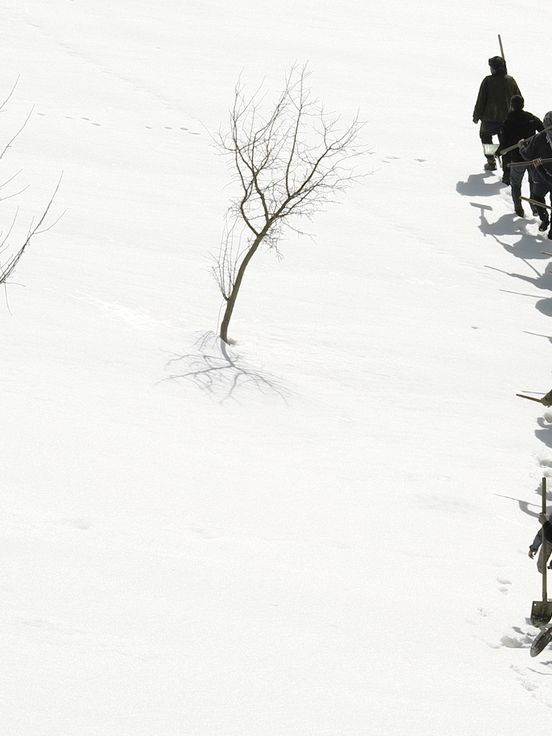Pınar Öğrenci (*1973 Van, Türkiye) works in the media film, video and installation. From a decolonial and feminist perspective she tackles themes at the interface between social, political and historical issues. Exploring material culture related to migration, forced displacement, state violence, survival and resistance is central to her artistic practice. She often integrates images, video and sound recordings from archives, removing them from their original context and weaving them into multi-layered poetic and atmospheric narratives.
For both Žilnik and Öğrenci the stairs of a building with multiple apartments are a collective space where tenants meet. Whereas Žilnik filmed in Munich, Öğrenci’s work is set in Chemnitz and depicts the anti-racist struggles of people living there. In the original film, where most of the interviewees had arrived under West German “recruitment agreements” as a 'guest', they are seen coming down the stairs. Öğrenci’s version shows the protagonists walking up, going to their apartments. It turns out that Öğrenci depicts Chemnitz as a permanent space rather than a temporary home for the migrants. They talk about their life histories, their connections to the region and their commitment against racism as well as the everyday experience of discrimination in its structural and its individual forms.
Aşît/The Avalanche, 2022
The Berlinische Galerie is showing her film “Aşît / The Avalanche” (2022, 60 min.), produced for documenta fifteen. The inspiration and starting point comes from Stefan Zweig’s “The Royal Game”, a novella he wrote in Brazilian exile in 1942 in which the game of chess becomes a survival strategy in the face of fascism. To make „Aşît“, Öğrenci returned to her father’s hometown Müküs (Bahçesaray in Turkish) in the region of Van, near the border between Türkiye and Iran. Until 1915 its education system and its cultural heritage were multilingual, with Armenian, Kurdish, Persian and Arabic existing side by side. Today a big percentage of the inhabitants are Kurds. The title “Aşît” means both “avalanche” and “disaster” in Kurdish. It refers to the avalanche that constantly threatens to cut Müküs off from the rest of the world and to “Meds Yeghern” (literally “The Great Disaster” of 1915), when 1.5 million Armenians were killed in the genocide during the First World War.
Öğrenci’s powerfully visual piece depicts day-to-day strategies adopted by local Kurdish people to resist state pressure. Her film shows traces of the different cultures that once lived in Müküs before parts of the population were murdered, displaced or forced to assimilate. Key roles are played by the Armenian musician Hayrik Muradian, who had to flee the Van region in 1918, and the songs that he collected from his homeland.
Trailer
Inventory, 2021
Another work by Pinar Öğrenci is presented online. “Inventory, 2021” is a remake of original 'Inventur – Metzstraße 11' made in 1975 by Yugoslavian director Želimir Žilnik. Žilnik (*1942), who won the Golden Bear at the 1969 Berlinale, is known for his critique of the regime. In the 1970s, repression by the Yugoslav government drove him into exile in West Germany, where he shone a light on the living conditions of so-called “guest workers”. Similarly, artist and filmmaker Pınar Öğrenci had to migrate to Germany in 2018 due to repression of the current regime in Turkey. She shot her first documentary film 'Gurbet is a home now' (2021) with former “guest workers” from Turkey and encountered Žilnik's 'Inventur' at the same time.
For both Žilnik and Öğrenci the stairs of a building with multiple apartments are a collective space where tenants meet. Whereas Žilnik filmed in Munich, Öğrenci’s work is set in Chemnitz and depicts the anti-racist struggles of people living there. In the original film, where most of the interviewees had arrived under West German “recruitment agreements” as a 'guest', they are seen coming down the stairs. Öğrenci’s version shows the protagonists walking up, going to their apartments. It turns out that Öğrenci depicts Chemnitz as a permanent space rather than a temporary home for the migrants. They talk about their life histories, their connections to the region and their commitment against racism as well as the everyday experience of discrimination in its structural and its individual forms.
IBB Video Space
Since 2011 the IBB Video Space has been screening artists who work with time-based media. The programme features not only established names in contemporary video art but also up-and-coming artists rarely seen in museums to date. For these, the Berlinische Galerie seeks to facilitate an institutional début.
Each screening brings a new encounter with work that raises questions about the medium and about social or political issues. Importance is attached to including marginalised perspectives and to shedding light on the impact of power structures.
